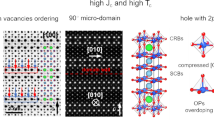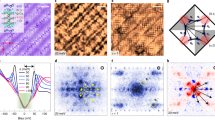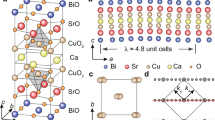Abstract
High-transition-temperature (high-Tc) superconductivity is ubiquitous in the cuprates containing CuO2 planes, but each cuprate has its own character. The study of the material dependence of the d-wave superconducting gap (SG) should provide important insights into the mechanism of high-Tc superconductivity. However, because of the ‘pseudogap’ phenomenon, it is often unclear whether the energy gaps observed by spectroscopic techniques really represent the SG. Here, we use scanning tunnelling spectroscopy to image nearly optimally doped Ca2−xNaxCuO2Cl2(Na-CCOC) with Tc=25–28 K. It enables us to observe the quasiparticle interference effect in this material, through which we obtain unambiguous information on the SG. Our analysis of quasiparticle interference in Na-CCOC reveals that the SG dispersion near the gap node is almost identical to that of Bi2Sr2CaCu2Oy (Bi2212) at the same doping level, despite the Tc of Bi2212 being three times higher than that of Na-CCOC. We also find that the SG in Na-CCOC is confined in narrower energy and momentum ranges than Bi2212, which explains—at least in part—the remarkable material dependence of Tc.
This is a preview of subscription content, access via your institution
Access options
Subscribe to this journal
Receive 12 print issues and online access
$209.00 per year
only $17.42 per issue
Buy this article
- Purchase on Springer Link
- Instant access to full article PDF
Prices may be subject to local taxes which are calculated during checkout




Similar content being viewed by others
References
Fischer, Ø., Kugler, M., Maggio-Aprile, I., Berthod, C. & Renner, C. Scanning tunneling spectroscopy of high-temperature superconductors. Rev. Mod. Phys. 79, 353–419 (2007).
Cren, T., Roditchev, D., Sacks, W. & Klein, J. Nanometer scale mapping of the density of states in an inhomogeneous superconductor. Eur. Phys. Lett. 54, 84–90 (2001).
Howald, C., Fournier, P. & Kapitulnik, A. Inherent inhomogeneities in tunneling spectra of Bi2Sr2CaCu2O8−x crystals in the superconducting state. Phys. Rev. B 64, 100504 (2001).
Pan, S. H. et al. Microscopic electronic inhomogeneity in the high-Tc superconductor Bi2Sr2CaCu2O8+x . Nature 413, 282–285 (2001).
Lang, K. M. et al. Imaging the granular structure of high-Tc superconductivity in underdoped Bi2Sr2CaCu2O8+δ . Nature 415, 412–416 (2002).
Kohsaka, Y. et al. Imaging nano-scale electronic inhomogeneity in lightly doped Mott insulator Ca2−xNaxCuO2Cl2 . Phys. Rev. Lett. 93, 097004 (2004).
Hoffman, J. E. et al. A four unit cell periodic pattern of quasi-particle states surrounding vortex cores in Bi2Sr2CaCu2O8+δ . Science 295, 466–469 (2002).
Vershinin, M. et al. Local ordering in the pseudogap state of the high-Tc superconductor Bi2Sr2CaCu2O8+δ . Science 303, 1995–1998 (2004).
Hanaguri, T. et al. A ‘checkerboard’ electronic crystal state in lightly hole-doped Ca2−xNaxCuO2Cl2 . Nature 430, 1001–1005 (2004).
McElroy, K. et al. Coincidence of checkerboard charge order and antinodal state decoherence in strongly underdoped superconducting Bi2Sr2CaCu2O8+δ . Phys. Rev. Lett. 94, 197005 (2005).
Damascelli, A., Hussain, Z. & Shen, Z.-X. Angle-resolved photoemission studies of the cuprate superconductors. Rev. Mod. Phys. 75, 473–541 (2003).
Shen, K. M. et al. Nodal quasiparticles and antinodal charge ordering in Ca2−xNaxCuO2Cl2 . Science 307, 901–904 (2005).
Yoshida, T. et al. Low-energy electronic structure of the high-Tc cuprates La2−xSrxCuO4 studied by angle-resolved photoemission spectroscopy. J. Phys. Condens. Matter 19, 125209 (2007).
Tanaka, K. et al. Distinct Fermi-momentum-dependent energy gaps in deeply underdoped Bi2212. Science 314, 1910–1913 (2006).
Norman, M. R. et al. Destruction of the Fermi surface in underdoped high-Tc superconductors. Nature 392, 157–160 (1998).
Tsuei, C. C. & Kirtley, J. R. Pairing symmetry in cuprate superconductors. Rev. Mod. Phys. 72, 969–1016 (2000).
Le Tacon, M. et al. Two energy scales and two distinct quasiparticle dynamics in the superconducting state of underdoped cuprates. Nature Phys. 2, 537–543 (2006).
Gomes, K. K. et al. Visualizing pair formation on the atomic scale in the high-Tc superconductor Bi2Sr2CaCu2O8+δ . Nature 447, 569–572 (2007).
Boyer, M. C. et al. Imaging the two gaps of the high-Tc superconductor Pb-Bi2Sr2CuO6+x. Nature Phys. published online 16 September 2007 (doi:10.1038/nphys725).
Timusk, T. & Statt, B. The pseudogap in high-temperature superconductors: an experimental survey. Rep. Prog. Phys. 62, 61–122 (1999).
Hoffman, J. E. et al. Imaging quasiparticle interference in Bi2Sr2CaCu2O8+δ . Science 297, 1148–1151 (2002).
McElroy, K. et al. Relating atomic-scale electronic phenomena to wave-like quasiparticle states in superconducting Bi2Sr2CaCu2O8+δ . Nature 422, 592–596 (2003).
Wang, Q. & Lee, D.-H. Quasiparticle scattering interference in high temperature superconductors. Phys. Rev. B 67, 020511 (2003).
Zhang, D. & Ting, C. S. Energy-dependent modulations in the local density of states of the cuprate superconductors. Phys. Rev. B 67, 100506 (2003).
Pereg-Barnea, T. & Franz, M. Theory of quasiparticle interference patterns in the pseudogap phase of the cuprate superconductors. Phys. Rev. B 68, 180506 (R) (2003).
Capriotti, L., Scalapino, D. J. & Sedgewick, R. D. Wave-vector power spectrum of the local tunneling density of states: Ripples in a d-wave sea. Phys. Rev. B 68, 014508 (2003).
Zhu, L., Atkinson, W. A. & Hirschfeld, P. J. Power spectrum of many impurities in a d-wave superconductor. Phys. Rev. B 69, 060503(R) (2004).
Pereg-Barnea, T. & Franz, M. Quasiparticle interference patterns as a test for the nature of the pseudogap phase in the cuprate superconductors. Int. J. Mod. Phys. B 19, 731–761 (2005).
Dell’Anna, L., Lorenzana, J., Capone, M., Castellani, C. & Grilli, M. Effect of mesoscopic inhomogeneities on local tunneling density of states in cuprates. Phys. Rev. B 71, 064518 (2005).
Cheng, M. & Su, W. P. Local density of states and angle-resolved photoemission spectral function of an inhomogeneous d-wave superconductor. Phys. Rev. B 72, 094512 (2005).
Nunner, T. S. et al. Fourier transform spectroscopy of d-wave quasiparticles in the presence of atomic scale pairing disorder. Phys. Rev. B 73, 104511 (2006).
Hasegawa, Y. & Avouris, Ph. Direct observation of standing wave formation at surface steps using scanning tunneling spectroscopy. Phys. Rev. Lett. 71, 1071–1074 (1993).
Crommie, M. F., Lutz, C. P. & Eigler, D. M. Imaging standing waves in a two-dimensional electron gas. Nature 363, 524–527 (1993).
Sprunger, P. T., Petersen, L., Plummer, E. W., Lægsgaard, E. & Besenbacher, F. Giant Friedel oscillations on the beryllium(0001) surface. Science 275, 1764–1767 (1997).
Tinkham, M. Introduction to Superconductivity 2nd edn, 43 (McGraw Hill, New York, 1996).
Hiroi, Z., Kobayashi, N. & Takano, M. Probable hole-doped superconductivity without apical oxygens in (Ca,Na)2CuO2Cl2 . Nature 371, 139–141 (1994).
Kohsaka, Y. et al. Growth of Na-doped Ca2CuO2Cl2 single crystals under high pressures of several GPa. J. Am. Chem. Soc. 124, 12275–12278 (2002).
Balatsky, A. V., Vekhter, I. & Zhu, J.-X. Impurity-induced states in conventional and unconventional superconductors. Rev. Mod. Phys. 78, 373–433 (2006).
Kohsaka, Y. et al. An intrinsic bond-centered electronic glass with unidirectional domains in underdoped cuprates. Science 314, 1380–1385 (2007).
Furukawa, N., Rice, T. M. & Salmhofer, M. Truncation of a two-dimensional FS due to quasiparticle gap formation at the saddle points. Phys. Rev. Lett. 81, 3195–3198 (1998).
Wen, X.-G. & Lee, P. A. Theory of quasiparticles in the underdoped high-Tc superconducting state. Phys. Rev. Lett. 80, 2193–2196 (1998).
Li, J.-X., Wu, C.-Q. & Lee, D.-H. Checkerboard charge density wave and pseudogap of high-Tc cuprates. Phys. Rev. B 74, 184515 (2006).
Garg, A., Randeria, M. & Trivedi, N. Strong correlations lead to protected low energy excitations in disordered d-wave superconductors. Preprint at <http://arXiv.org/cond-mat/0609666> (2006).
Oda, M., Dipasupil, R. M., Momono, N. & Ido, M. Hyperbolic dependence of 2Δ0 vs. Tc ratio on hole-doping level in high-Tc cuprates: Energy scale in determining Tc . J. Phys. Soc. Jpn. 69, 983–984 (2000).
Hanaguri, T. Development of high-field STM and its application to the study on magnetically-tuned criticality in Sr3Ru2O7 . J. Phys. Conf. Ser. 51, 514–521 (2006).
Acknowledgements
The authors thank A.V. Balatsky, C.-M. Ho, D.-H. Lee, K. Machida, A. Mackenzie, K. McElroy, T. Tohyama, J. Zaanen and F.-C. Zhang for discussions. They also thank J. Matsuno and P. Sharma for critical readings. T.H., M.T. and H.T. are supported by a Grant-in-Aid for Scientific Research from the Ministry of Education, Culture, Sports, Science and Technology of Japan. J.C.D. and Y.K. acknowledge support from Brookhaven National Laboratory under contract No DE-AC02-98CH1886 with the US Department of Energy, from the US Department of Energy Award No DE-FG02-06ER46306 and from the US Office of Naval Research.
Author information
Authors and Affiliations
Contributions
T.H. was responsible for all aspects of this project except sample growth. Y.K., J.C.D. and C.L. contributed the project planning and data analysis. I.Y., M.A., M.T. and K.O. grew samples and M.O. contributed the STM measurements. H.T. contributed the project planning and managed the whole project.
Corresponding author
Rights and permissions
About this article
Cite this article
Hanaguri, T., Kohsaka, Y., Davis, J. et al. Quasiparticle interference and superconducting gap in Ca2−xNaxCuO2Cl2. Nature Phys 3, 865–871 (2007). https://doi.org/10.1038/nphys753
Received:
Accepted:
Published:
Issue Date:
DOI: https://doi.org/10.1038/nphys753
This article is cited by
-
Critical nematic correlations throughout the superconducting doping range in Bi2−zPbzSr2−yLayCuO6+x
Nature Communications (2023)
-
The emergence of global phase coherence from local pairing in underdoped cuprates
Nature Physics (2023)
-
Particle–hole asymmetric superconducting coherence peaks in overdoped cuprates
Nature Physics (2022)
-
Multi-atom quasiparticle scattering interference for superconductor energy-gap symmetry determination
npj Quantum Materials (2021)
-
Superconductor-to-metal transition in overdoped cuprates
npj Quantum Materials (2021)



